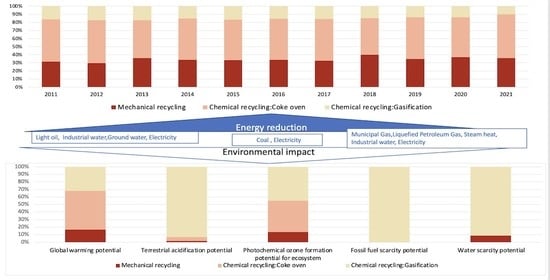Environmental Impact of Plastic Recycling in Terms of Energy Consumption: A Comparison of Japan’s Mechanical and Chemical Recycling Technologies
Abstract
1. Introduction
2. Literature Review
2.1. Plastic Recycling Contribution to the Creation of a Circular Economy and Energy Security in Japan
2.2. Mechanical, Chemical, and Thermal Plastic Recycling
| Advantages | Disadvantages | References | |
|---|---|---|---|
| MR | Straightforward process | Mixed plastics separation difficulty and high cost are known as Mechanical Recycling (MR) challenges. | [52,53] |
| Recycling facilities are simple and economical and use less energy and resources than CR. | Lower product quality. Products may not be able to be reused in high legal safety required products such as food packaging. | [50,52,54,55] | |
| Although it emits the lowest overall GHG emission but is not consistently distributed across cycles. | [54,55] | ||
| Emits high NOx emission. | [55,57] | ||
| MR is known as being more popular and mature than CR. | [55] | ||
| It can selectively convert plastic waste into high-value products such as refinery feedstock, fuel, and monomer. | Require high investment and clean feedstocks | [56,61] | |
| CR | Higher potential for profitability | Readiness level for industrial scale has not been completely established | [52,55] |
| Require much energy | Industrial implementation of CR is limited because it is less tolerant of contaminants. | [52,58] | |
| The pyrolysis route emits lower SOx emissions. | [57] | ||
| In the gasification route, polymer separation into different categories is not necessary. It also produces useful electricity and heat. | [61] | ||
| Gasification is considered a mature technology. | [61] | ||
| High process efficiency | [58] |
3. Materials and Methods
Research Scope, Inventory, and Environmental Impact Analysis
| Mi | Unit (MJ) | CO2 (Kg) | CH4 (g) | N2O (g) | SOx (g) | NOx (g) |
|---|---|---|---|---|---|---|
| Publicity Electricity | 0.4 × 101 | 4 × 10−1 | 0 | 2 × 10−3 | 0 | 2 × 10−1 |
| Light oil | 0.4 × 102 | 0.3 × 101 | n.a | n.a | 1.4 × 10−1 | 0.1 × 101 |
| Industrial water | 1.7 × 10−3 | 1.1 × 10−4 | 0 | 0.2 × 10−2 | 0.5 × 10−5 | 3.6 × 10−4 |
| Steam heat | 0.4 × 101 | 2.6 × 10−1 | 0 | 0.3 × 10−1 | 0.2 × 10−4 | 5 × 10−1 |
| LPG | 0.6 × 102 | 0.4 × 101 | 9 × 10−1 | n.a | 7 × 10−1 | 0.2 × 101 |
| Municipal gas | 5.7 × 101 | 0.3 × 101 | n.a | n.a | 4.6 × 10−2 | 0.12 × 101 |
4. Results and Discussion
5. Conclusions
- (1)
- The quality of products and byproducts determine the utilization rates.
- (2)
- How good the collection and separation process are, as they determine whether more advanced technologies with lower contamination tolerance can be adopted.
- (3)
- The existence of mixed plastics is more costly and challenging to handle.
- (4)
- How ambitious the country is about progressing toward a circular economy.
- (5)
- How to accommodate policymakers and how cooperative and transparent stakeholders are about creating industrial symbiosis, as policy and data sharing are key to successful industrial symbiosis.
Author Contributions
Funding
Data Availability Statement
Acknowledgments
Conflicts of Interest
References
- OECD. Global Plastics Outlook; OECD Publishing: Paris, France, 2022. [Google Scholar] [CrossRef]
- Leal Filho, W.; Salvia, A.L.; Minhas, A.; Paço, A.; Dias-Ferreira, C. The COVID-19 Pandemic and Single-Use Plastic Waste in Households: A Preliminary Study. Sci. Total Environ. 2021, 793, 148571. [Google Scholar] [CrossRef] [PubMed]
- Plastic Waste Management Institute (Both in Japanese and English). Available online: https://www.pwmi.or.jp/index.php (accessed on 15 January 2023).
- Vanapalli, K.R.; Sharma, H.B.; Ranjan, V.P.; Samal, B.; Bhattacharya, J.; Dubey, B.K.; Goel, S. Challenges and Strategies for Effective Plastic Waste Management during and Post COVID-19 Pandemic. Sci. Total Environ. 2021, 750, 141514. [Google Scholar] [CrossRef] [PubMed]
- IEA Chemicals–Analysis. Available online: https://www.iea.org/reports/chemicals (accessed on 15 January 2023).
- Minister’s Secretariat; Waste Management and Recycling Department Policy Planning Division, Office of Sound Material-Cycle Socie. History and Current State of Waste Management in Japan; Ministry of Environment Publishing: Tokyo, Japan, 2014. Available online: https://www.env.go.jp/content/900453392.pdf (accessed on 15 January 2023).
- Sasao, T. Why Is Plastic Recycling Expensive? Hybrid Panel Data Analysis of Recyclable Plastic Containers and Packaging in Japan. Resour. Conserv. Recycl. 2022, 185, 106505. [Google Scholar] [CrossRef]
- The Japan Plastics Industry Federation. Resource Circulation Strategy for Plastics; The Japan Plastics Industry Federation: Tokyo, Japan, 2019; Available online: http://www.jpif.gr.jp/english/resource_circulation_strategy_for_plastics.pdf (accessed on 3 February 2023).
- Yamamoto, M.; Eva, S.N. What Activities Reduce Plastic Waste the Most?—The Path to a Circular Economy for Japan’s Manufacturing Industry. Waste Manag. 2022, 151, 205–213. [Google Scholar] [CrossRef] [PubMed]
- PWMI. An Introduction to Plastic Recycling; PWMI Publishing: Tokyo, Japan, 2019; Available online: https://www.pwmi.or.jp/ei/plastic_recycling_2019.pdf (accessed on 13 January 2023).
- Plastic Waste Management Institute. Plastic Recycling Flow-Chart (2021 Year). PWMI Publishing. Available online: https://www.pwmi.or.jp/pdf/panf2.pdf (accessed on 3 February 2023).
- Davidson, M.G.; Furlong, R.A.; Mcmanus, M.C. Developments in the Life Cycle Assessment of Chemical Recycling of Plastic Waste e A Review. J. Clean. Prod. 2021, 293, 126163. [Google Scholar] [CrossRef]
- Feil, A.; Pretz, T. Mechanical Recycling of Packaging Waste. In Plastic Waste and Recycling; Academic Press: Cambridge, MA, USA, 2020. [Google Scholar] [CrossRef]
- Herrador, M.; de Jong, W.; Nasu, K.; Granrath, L. Circular Economy and Zero-Carbon Strategies between Japan and South Korea: A Comparative Study. Sci. Total Environ. 2022, 820, 153274. [Google Scholar] [CrossRef] [PubMed]
- METI Japan’s Roadmap to “Beyond-Zero” Carbon. Available online: https://www.meti.go.jp/english/policy/energy_environment/global_warming/roadmap/ (accessed on 14 February 2023).
- METI Present Status and Promotion Measures for the Introduction of Renewable Energy in Japan. Available online: https://www.meti.go.jp/english/policy/energy_environment/renewable/ref1003.html (accessed on 14 February 2023).
- IGES Japan 2050 Low Cabon Navigator. Available online: http://www.en-2050-low-carbon-navi.jp/pathways/11111111111111111111111111111111111111111111111/three_e_s (accessed on 14 February 2023).
- European Commission Waste Prevention and Management—Environment. Available online: https://ec.europa.eu/environment/green-growth/waste-prevention-and-management/index_en.htm (accessed on 15 January 2023).
- Schyns, Z.O.; Shaver, M.P. Mechanical Recycling of Packaging Plastics: A Review. Macromol. Rapid Commun. 2020, 42, e2000415. [Google Scholar] [CrossRef]
- Arena, U.; Mastellone, M.L.; Perugini, F. Plastic Packaging Recycling LCA Case Studies Life Cycle Assessment of a Plastic Packaging Recycling System. Int. J. Life Cycle Assess. 2003, 8, 92–98. [Google Scholar] [CrossRef]
- Perugini, F.; Mastellone, M.L.; Arena, U.; Prog, E. A Life Cycle Assessment of Mechanical and Feedstock Recycling Options for Management of Plastic Packaging Wastes. Environ. Prog. 2005, 24, 137–154. [Google Scholar] [CrossRef]
- Okuwaki, A. Feedstock Recycling of Plastics in Japan. Polym. Degrad. Stab. 2004, 85, 981–988. [Google Scholar] [CrossRef]
- EMBER Top 15 Wind and Solar Power Countries in 2020|Ember. Available online: https://ember-climate.org/insights/research/top-15-wind-and-solar-power-countries-in-2020/ (accessed on 14 February 2023).
- Cheng, C.; Blakers, A.; Stocks, M.; Lu, B. 100% Renewable Energy in Japan. Energy Convers. Manag. 2022, 255, 115299. [Google Scholar] [CrossRef]
- Karasoy, A. Is Innovative Technology a Solution to Japan’s Long-Run Energy Insecurity? Dynamic Evidence from the Linear and Nonlinear Methods. Technol. Soc. 2022, 70, 102029. [Google Scholar] [CrossRef]
- International Energy Agency. Japan 2021—Energy Policy Review; IEA Publishing: Paris, France, 2021; Available online: https://www.iea.org/reports/japan-2021 (accessed on 14 February 2023).
- Ozawa, A.; Tsani, T.; Kudoh, Y. Using an Energy Modeling Methodology. Renew. Sustain. Energy Rev. 2022, 169, 112943. [Google Scholar] [CrossRef]
- Gao, L.; Ashina, S. Willingness-to-Pay Promoted Renewable Energy Diffusion: The Case of Japan’s Electricity Market. J. Clean. Prod. 2022, 330, 129828. [Google Scholar] [CrossRef]
- Castaño-Rosa, R.; Okushima, S. Prevalence of Energy Poverty in Japan: A Comprehensive Analysis of Energy Poverty Vulnerabilities. Renew. Sustain. Energy Rev. 2021, 145, 111006. [Google Scholar] [CrossRef]
- Yajima, N.; Arimura, T.H. Promoting Energy Efficiency in Japanese Manufacturing Industry through Energy Audits: Role of Information Provision, Disclosure, Target Setting, Inspection, Reward, and Organizational Structure. Energy Econ. 2022, 114, 106253. [Google Scholar] [CrossRef]
- Itaoka, K.; Chapman, A.; Farabi-Asl, H. Underpinnings of Consumer Preferences and Participation in Japan’s Liberalized Energy Market. Util. Policy 2022, 76, 101379. [Google Scholar] [CrossRef]
- Shiraki, H.; Ashina, S.; Kameyama, Y.; Hashimoto, S.; Fujita, T. Analysis of Optimal Locations for Power Stations and Their Impact on Industrial Symbiosis Planning under Transition toward Low-Carbon Power Sector in Japan. J. Clean. Prod. 2016, 114, 81–94. [Google Scholar] [CrossRef]
- MOFA Achieving Net Zero GHG Emissions by 2050 in Japan Policies and Measures Update. Available online: https://www.mofa.go.jp/files/100153687.pdf (accessed on 14 February 2023).
- Niyommaneerat, W.; Suwanteep, K.; Chavalparit, O. Sustainability Indicators to Achieve a Circular Economy: A Case Study of Renewable Energy and Plastic Waste Recycling Corporate Social Responsibility (CSR) Projects in Thailand. J. Clean. Prod. 2023, 391, 136203. [Google Scholar] [CrossRef]
- European Union Circular Economy Roadmap of France: 50 Measures for a 100% Circular Economy|European Circular Economy Stakeholder Platform. Available online: https://circulareconomy.europa.eu/platform/en/strategies/circular-economy-roadmap-france-50-measures-100-circular-economy (accessed on 14 February 2023).
- UNEP Visual Feature|Beat Plastic Pollution. Available online: https://www.unep.org/interactives/beat-plastic-pollution/ (accessed on 14 February 2023).
- Hossain, R.; Islam, M.T.; Ghose, A.; Sahajwalla, V. Full Circle: Challenges and Prospects for Plastic Waste Management in Australia to Achieve Circular Economy. J. Clean. Prod. 2022, 368, 133127. [Google Scholar] [CrossRef]
- Schlüter, L.; Mortensen, L.; Drustrup, R.; Gjerding, A.N.; Kørnøv, L.; Lyhne, I. Uncovering the Role of the Industrial Symbiosis Facilitator in Literature and Practice in Nordic Countries: An Action-Skill Framework. J. Clean. Prod. 2022, 379, 134652. [Google Scholar] [CrossRef]
- Silva, M.G.; de Carvalho, T.S.; Castagna, A.G.; Strauhs, F.D.R.; Piekarski, C.M. The Role of Online Platforms to Enable the Process of Industrial Symbiosis: An Analysis of Tools Available in the Market. Clean. Prod. Lett. 2022, 3, 100021. [Google Scholar] [CrossRef]
- Wang, L.; Zhang, Q.; Zhang, G.; Wang, D.; Liu, C. Can Industrial Symbiosis Policies Be Effective? Evidence from the Nationwide Industrial Symbiosis System in China. J. Environ. Manag. 2023, 331, 117346. [Google Scholar] [CrossRef] [PubMed]
- Dong, L.; Taka, G.N.; Lee, D.; Park, Y.; Park, H.S. Tracking Industrial Symbiosis Performance with Ecological Network Approach Integrating Economic and Environmental Benefits Analysis. Resour. Conserv. Recycl. 2022, 185, 106454. [Google Scholar] [CrossRef]
- Sellitto, M.A.; Murakami, F.K.; Butturi, M.A.; Marinelli, S.; Kadel, N.; Rimini, B. Barriers, Drivers, and Relationships in Industrial Symbiosis of a Network of Brazilian Manufacturing Companies. Sustain. Prod. Consum. 2021, 26, 443–454. [Google Scholar] [CrossRef]
- Taqi, H.M.M.; Meem, E.J.; Bhattacharjee, P.; Salman, S.; Ali, S.M. What Are the Challenges That Make the Journey towardstoward Industrial Symbiosis Complicated? J. Clean. Prod. 2022, 370, 133384. [Google Scholar] [CrossRef]
- Chen, X.; Dong, M.; Zhang, L.; Luan, X.; Cui, X.; Cui, Z. Comprehensive Evaluation of Environmental and Economic Benefits of Industrial Symbiosis in Industrial Parks. J. Clean. Prod. 2022, 354, 131635. [Google Scholar] [CrossRef]
- Heinrich Boll Stiftung. PLASTIC ATLAS—Facts and Figures about the World of Synthetic Polymers (Asia Edition); Heinrich Böll Foundation: Berlin, Germany, 2021; ISBN 9789887561903. [Google Scholar]
- Statista • Chart: Which Countries Export & Import Plastic Waste?|Statista. Available online: https://www.statista.com/chart/18229/biggest-exporters-of-plastic-waste-and-scrap/ (accessed on 16 August 2022).
- Morita, Y.; Hayashi, S. Proposals to Strengthen Japan’s Domestic Measures and Regional Cooperation on Stable and Environmentally Sound Plastic Scrap Recycling: Response to China’s Ban on Imports of Plastic Scrap; Angewandte Chemie International Edition; Institute for Global Environmental Strategies: Hayama, Japan, 2018; Volume 6, pp. 951–952. [Google Scholar]
- Akenji, L.; Bengtsson, M.; Hotta, Y.; Kato, M.; Hengesbaugh, M. Policy Responses to Plastic Pollution in Asia; Elsevier Inc.: Amsterdam, The Netherlands, 2020; ISBN 9780128178805. [Google Scholar]
- UN Comtrade UN Comtrade|International Trade Statistics Database. Available online: https://comtrade.un.org/ (accessed on 24 August 2022).
- van der Hulst, M.K.; Ottenbros, A.B.; van der Drift, B.; Ferjan, Š.; van Harmelen, T.; Schwarz, A.E.; Worrell, E.; van Zelm, R.; Huijbregts, M.A.J.; Hauck, M. Greenhouse Gas Benefits from Direct Chemical Recycling of Mixed Plastic Waste. Resour. Conserv. Recycl. 2022, 186, 106582. [Google Scholar] [CrossRef]
- FICCI Conference on Potential of Plastics Industry in Northern India with Special Focus to Plasticulture and Packaging: A Report on Plastics Industry. Available online: https://ficci.in/search_page.asp# (accessed on 14 February 2023).
- Naderi Kalali, E.; Lotfian, S.; Entezar Shabestari, M.; Khayatzadeh, S.; Zhao, C.; Yazdani Nezhad, H. A Critical Review of the Current Progress of Plastic Waste Recycling Technology in Structural Materials. Curr. Opin. Green Sustain. Chem. 2023, 2023, 100763. [Google Scholar] [CrossRef]
- Jung, H.; Shin, G.; Kwak, H.; Hao, L.T.; Jegal, J.; Kim, H.J.; Jeon, H.; Park, J.; Oh, D.X. Review of Polymer Technologies for Improving the Recycling and Upcycling Efficiency of Plastic Waste. Chemosphere 2023, 320, 138089. [Google Scholar] [CrossRef]
- Van Fan, Y.; Čuček, L.; Krajnc, D.; Klemeš, J.J.; Lee, C.T. Life Cycle Assessment of Plastic Packaging Recycling Embedded with Responsibility Distribution as Driver for Environmental Mitigation. Sustain. Chem. Pharm. 2023, 31, 100946. [Google Scholar] [CrossRef]
- Huysveld, S.; Ragaert, K.; Demets, R.; Nhu, T.T.; Civancik-Uslu, D.; Kusenberg, M.; van Geem, K.M.; de Meester, S.; Dewulf, J. Technical and Market Substitutability of Recycled Materials: Calculating the Environmental Benefits of Mechanical and Chemical Recycling of Plastic Packaging Waste. Waste Manag. 2022, 152, 69–79. [Google Scholar] [CrossRef] [PubMed]
- Soares, C.T.d.M.; Ek, M.; Östmark, E.; Gällstedt, M.; Karlsson, S. Recycling of Multi-Material Multilayer Plastic Packaging: Current Trends and Future Scenarios. Resour. Conserv. Recycl. 2022, 176, 105905. [Google Scholar] [CrossRef]
- Lim, J.; Ahn, Y.; Kim, J. Optimal Sorting and Recycling of Plastic Waste as a Renewable Energy Resource Considering Economic Feasibility and Environmental Pollution. Process Saf. Environ. Prot. 2023, 169, 685–696. [Google Scholar] [CrossRef]
- Huang, J.; Veksha, A.; Chan, W.P.; Giannis, A.; Lisak, G. Chemical Recycling of Plastic Waste for Sustainable Material Management: A Prospective Review on Catalysts and Processes. Renew. Sustain. Energy Rev. 2022, 154, 111866. [Google Scholar] [CrossRef]
- Zhang, F.; Wang, F.; Wei, X.; Yang, Y.; Xu, S.; Deng, D.; Wang, Y.-Z. From Trash to Treasure: Chemical Recycling and Upcycling of Commodity Plastic Waste to Fuels, High-Valued Chemicals and Advanced Materials. J. Energy Chem. 2022, 69, 369–388. [Google Scholar] [CrossRef]
- Kusenberg, M.; Eschenbacher, A.; Delva, L.; de Meester, S.; Delikonstantis, E.; Stefanidis, G.D.; Ragaert, K.; van Geem, K.M. TowardsToward High-Quality Petrochemical Feedstocks from Mixed Plastic Packaging Waste via Advanced Recycling: The Past, Present and Future. Fuel Process. Technol. 2022, 238, 107474. [Google Scholar] [CrossRef]
- Jiang, J.; Shi, K.; Zhang, X.; Yu, K.; Zhang, H.; He, J.; Ju, Y.; Liu, J. From Plastic Waste to Wealth Using Chemical Recycling: A Review. J. Environ. Chem. Eng. 2022, 10, 106867. [Google Scholar] [CrossRef]
- Mostashari-Rad, F.; Ghasemi-Mobtaker, H.; Taki, M.; Ghahderijani, M.; Kaab, A.; Chau, K.-W.; Nabavi-Pelesaraei, A. Exergoenvironmental Damages Assessment of Horticultural Crops Using ReCiPe2016 and Cumulative Exergy Demand Frameworks. J. Clean. Prod. 2021, 278, 123788. [Google Scholar] [CrossRef]
- MHuijbregts, M.A.; Steinmann, Z.J.; Elshout, P.M.; Stam, G.; Verones, F.; Vieira, M.; van Zelm, R. ReCiPe 2016 v1.1 A Harmonized Life Cycle Impact Assessment Method at Midpoint and Endpoint Level Report I: Characterization; RIVM Report: Amsterdam, The Netherlands, 2016. [Google Scholar]
- Hauschild, M.Z.; Rosenbaum, R.K.; Olsen, S.I. Introduction to LCA Methodology. In Life Cycle Assess; Theory Pract; Springer International Publishing: New York, NY, USA, 2017; pp. 59–66. [Google Scholar] [CrossRef]
- ISO (the International Organization for Standardization) ISO-ISO 14040:2006-Environmental Management—Life Cycle Assessment—Principles and Framework. Available online: https://www.iso.org/standard/37456.html (accessed on 28 January 2023).
- ISO (the International Organization for Standardization) ISO-ISO 14044:2006-Environmental Management—Life Cycle Assessment—Requirements and Guidelines. Available online: https://www.iso.org/standard/38498.html (accessed on 28 January 2023).
- LCA Japan Forum JLCA-LCA Database 2022 Fy 2nd Edition. Available online: https://www-lca--forum-org.translate.goog/?_x_tr_sl=ja&_x_tr_tl=en&_x_tr_hl=ja (accessed on 28 January 2023).
- Nomura, S. Blast Furnace Feedstock and Coke Oven Chemical Feedstock. In Plastic Waste Recycingl; Letcher, T.M., Ed.; Elsevier: Amsterdam, The Netherlands, 2020; pp. 321–358. [Google Scholar] [CrossRef]
- Zhao, X.; Korey, M.; Li, K.; Copenhaver, K.; Tekinalp, H.; Celik, S.; Kalaitzidou, K.; Ruan, R.; Ragauskas, A.J.; Ozcan, S. Plastic Waste Upcycling toward a Circular Economy. Chem. Eng. J. 2022, 428, 131928. [Google Scholar] [CrossRef]
- The Japan Containers and Packaging Recycling Association (JCPRA). Investigation of Environmental Load, Etc. Related to Recycling Methods of Plastic Containers and Packaging (Summary Version); The Japan Containers and Packaging Recyling Association Publishing: Tokyo, Japan, 2017. [Google Scholar]
- JCPRA The Japan Containers and Packaging Recycling Association. Available online: https://www.jcpra.or.jp/english/tabid/603/index.php (accessed on 14 February 2023).
- JCPRA Environmental Impact Reduction of Plastic containers and Packaging recycling. Available online: https://www.jcpra.or.jp/recycle/recycling/tabid/435/index.php (accessed on 15 February 2023).
- Naoko Kutty Discover How Japan Is Preparing for the Global Energy Crisis. Available online: https://www.weforum.org/agenda/2022/11/how-japan-is-preparing-for-the-energy-crisis-this-winter/ (accessed on 30 January 2023).
- Cagno, E.; Negri, M.; Neri, A.; Giambone, M. One Framework to Rule Them All: An Integrated, Multi-Level and Scalable Performance Measurement Framework of Sustainability, Circular Economy and Industrial Symbiosis. Sustain. Prod. Consum. 2023, 35, 55–71. [Google Scholar] [CrossRef]
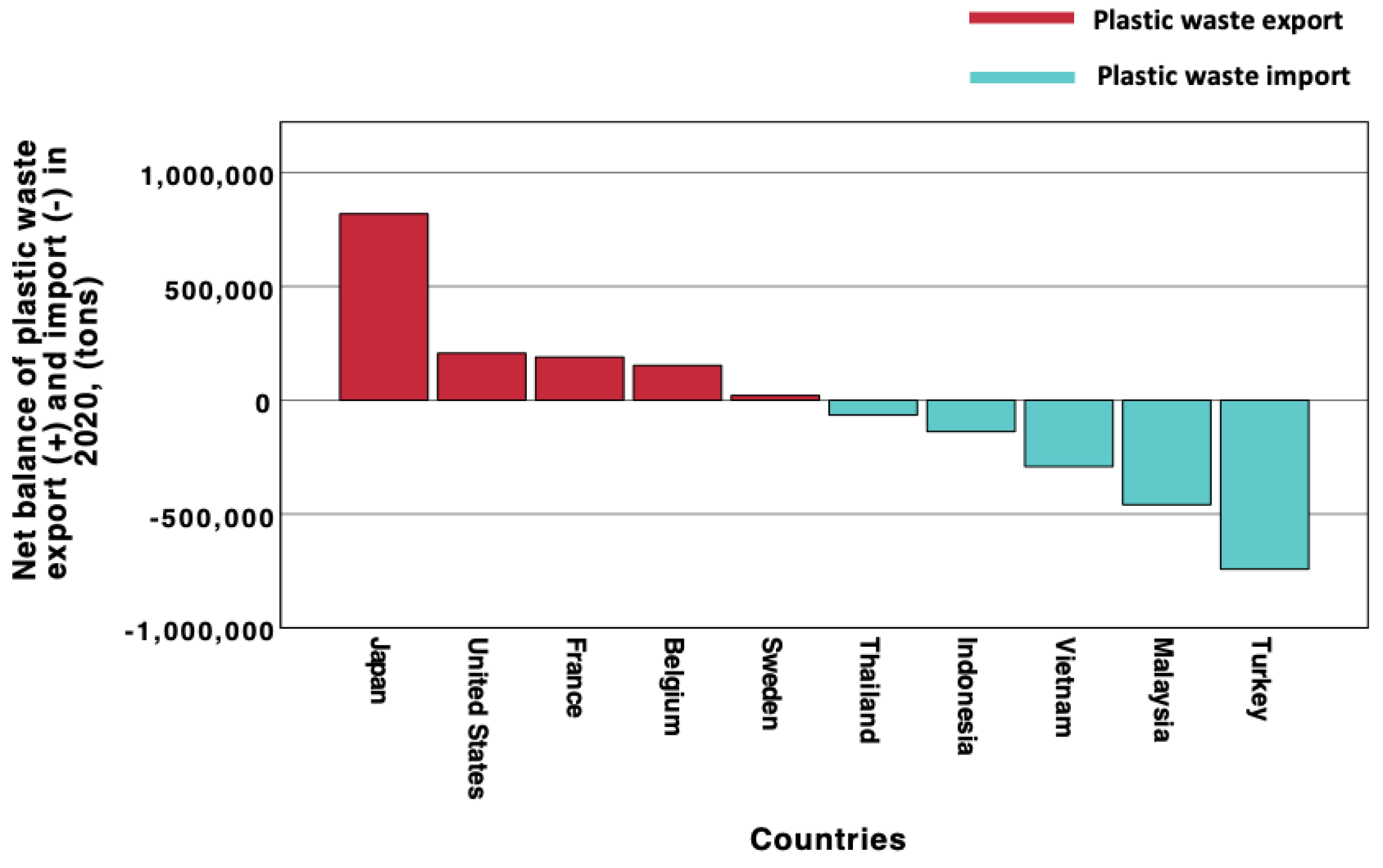
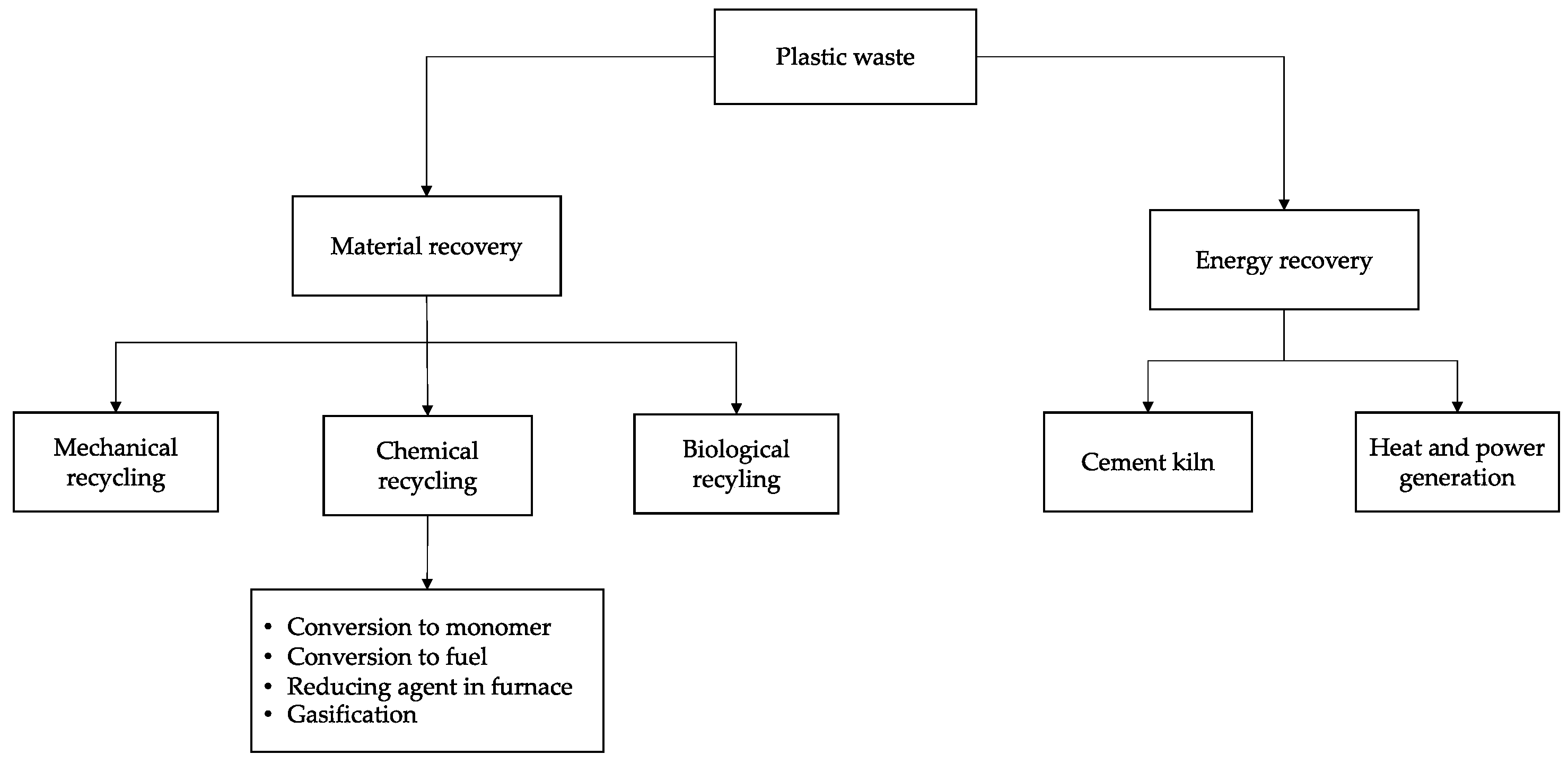
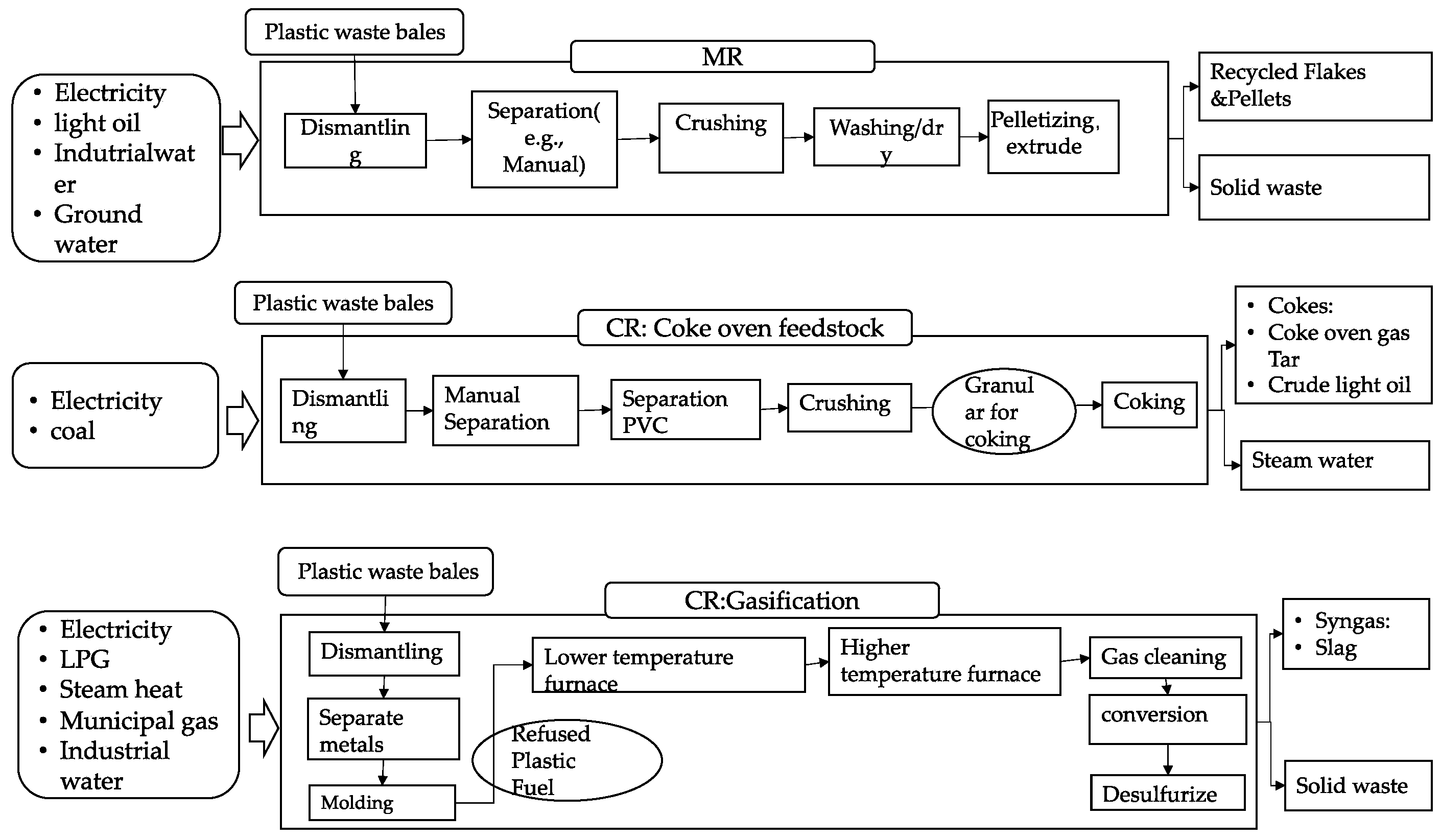
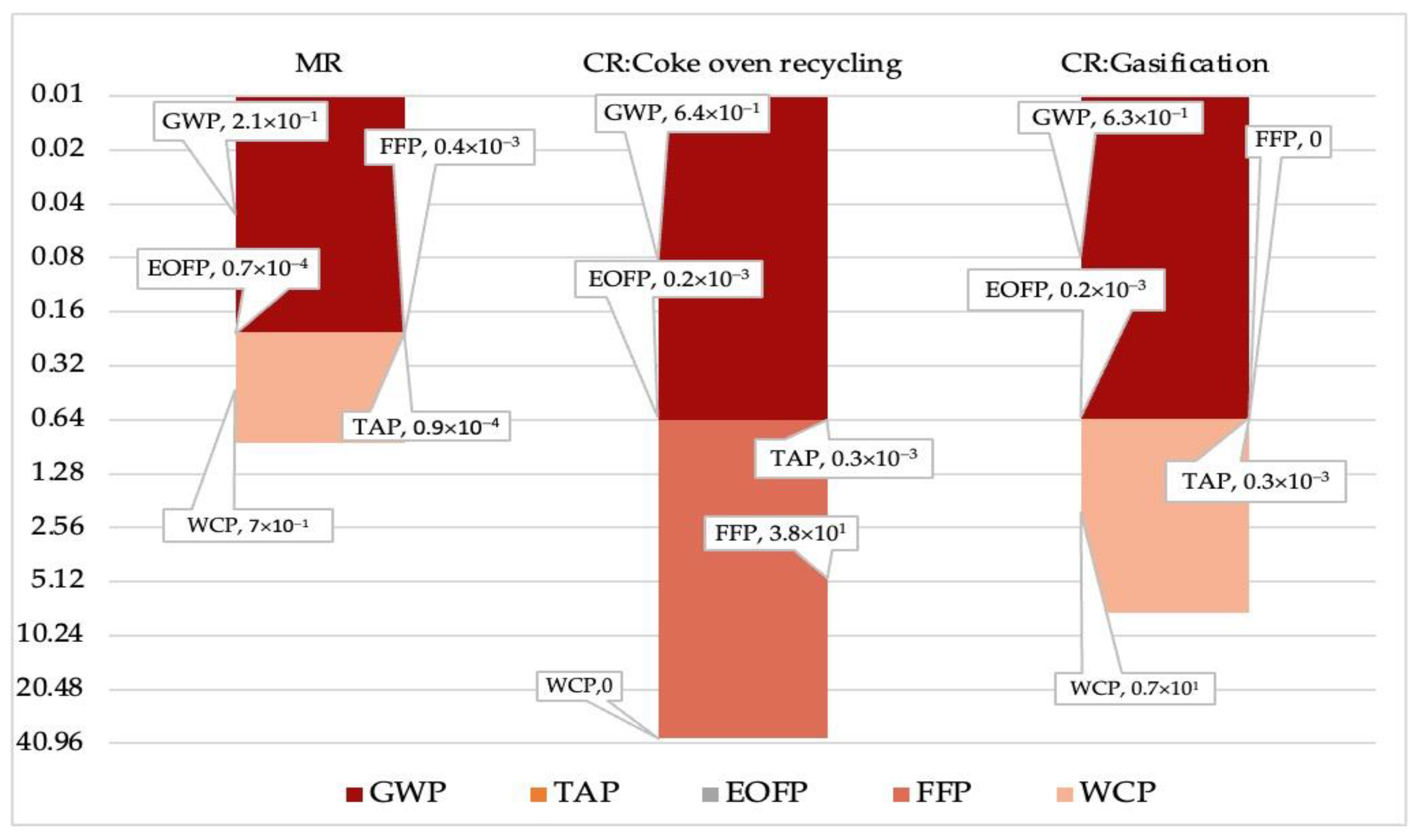
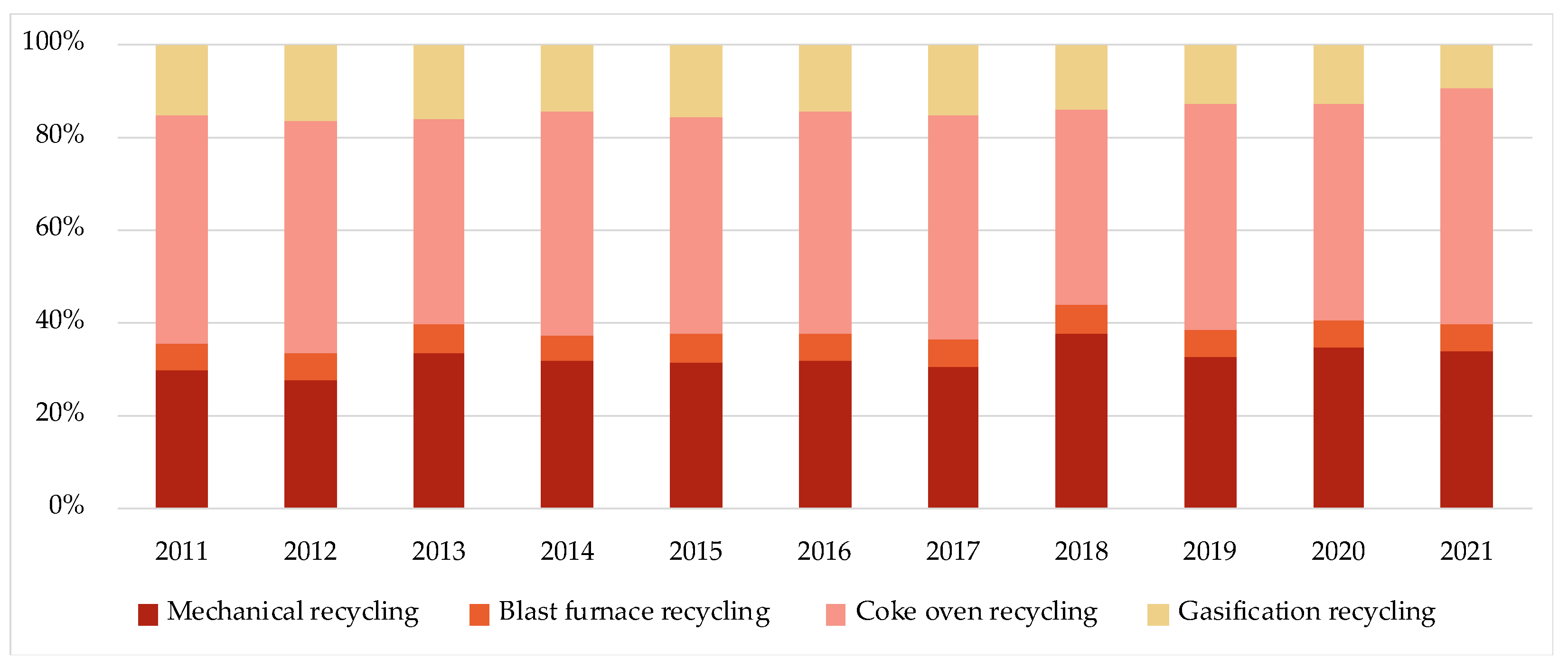
| Unit | MR | Coke Oven | Gasification | Reference | |
|---|---|---|---|---|---|
| Publicity Electricity | kWh | 5 × 10−1 | 0.9 × 101 | 2 × 10−1 | JLCI |
| Light oil | L | 5 × 10−4 | 0 | 0 | JLCI |
| Industrial water | m3 | 2 × 10−1 | 0 | 0.3 × 101 | JLCI |
| Ground water | m3 | 5 × 10−1 | 0 | 0 | JLCI |
| Liquefied petroleum gas (LPG) | kg | 0 | 0 | 3 × 10−3 | JLCI |
| Steam Heat | kg | 0 | 0 | 3 × 10−1 | JLCI |
| Municipal gas | kg | 0 | 0 | 4 × 10−3 | JLCI |
| Coal | kg | 0 | 0.9 × 102 | 0 | JLCI |
| Midpoint Impact Category Index | CF (Characterization Factors) | Emitted Factor Related Sources | Individualist | Unit |
|---|---|---|---|---|
| Climate change | GWP | CO2 | 0.1 × 101 | kg CO2-eq/kg GHG |
| CH4 | 0.8 × 102 | kg CO2-eq/kgGHG | ||
| N2O | 0.3 × 103 | kg CO2-eq/kg GHG | ||
| Terrestrial acidification | TAP | NOx | 3 × 10−1 (Japan) | kg SO2-eq/kg |
| SO2 | 8 × 10−1 (Japan) | kg SO2-eq/kg | ||
| Photochemical oxidant formation: terrestrial ecosystems | EOFP | NOx | 8 × 10−1 (Japan) | kg NOx-eq/kg |
| Fossil resource scarcity potential | FFP | Crude Oil | 0.1 × 101 | kg oil-eq/kg |
| Natural gas | 8 × 10−1 | kg oil-eq/Nm3 | ||
| Hard coal | 4.2 × 10−1 | kg oil-eq/kg | ||
| Water scarcity potential | WCP | Groundwater | 0.1 × 101 | m3 |
Disclaimer/Publisher’s Note: The statements, opinions and data contained in all publications are solely those of the individual author(s) and contributor(s) and not of MDPI and/or the editor(s). MDPI and/or the editor(s) disclaim responsibility for any injury to people or property resulting from any ideas, methods, instructions or products referred to in the content. |
© 2023 by the authors. Licensee MDPI, Basel, Switzerland. This article is an open access article distributed under the terms and conditions of the Creative Commons Attribution (CC BY) license (https://creativecommons.org/licenses/by/4.0/).
Share and Cite
Shan, C.; Pandyaswargo, A.H.; Onoda, H. Environmental Impact of Plastic Recycling in Terms of Energy Consumption: A Comparison of Japan’s Mechanical and Chemical Recycling Technologies. Energies 2023, 16, 2199. https://doi.org/10.3390/en16052199
Shan C, Pandyaswargo AH, Onoda H. Environmental Impact of Plastic Recycling in Terms of Energy Consumption: A Comparison of Japan’s Mechanical and Chemical Recycling Technologies. Energies. 2023; 16(5):2199. https://doi.org/10.3390/en16052199
Chicago/Turabian StyleShan, Chaoxia, Andante Hadi Pandyaswargo, and Hiroshi Onoda. 2023. "Environmental Impact of Plastic Recycling in Terms of Energy Consumption: A Comparison of Japan’s Mechanical and Chemical Recycling Technologies" Energies 16, no. 5: 2199. https://doi.org/10.3390/en16052199
APA StyleShan, C., Pandyaswargo, A. H., & Onoda, H. (2023). Environmental Impact of Plastic Recycling in Terms of Energy Consumption: A Comparison of Japan’s Mechanical and Chemical Recycling Technologies. Energies, 16(5), 2199. https://doi.org/10.3390/en16052199





